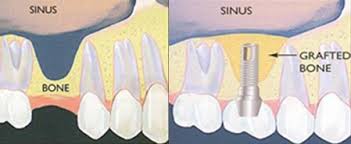The maxillary sinuses are behind your cheeks and on top of the upper teeth. These sinuses are empty, air-filled spaces. Some of the roots of the natural upper teeth extend up into the maxillary sinuses. When these upper teeth are removed, there is often just a thin wall of bone separating the maxillary sinus and the mouth. Dental implants need bone to hold them in place. When the sinus wall is very thin, it is impossible to place dental implants in this bone. A sinus lift or augmentation procedure is used for patients who need dental implants, but have thin sinus walls. Dr. Farbod can enter the sinus from where the upper teeth used to be, either directly above or to the side of the location. The sinus membrane is gently lifted and bone is inserted into the floor of the sinus. The site is closed, sometimes with a resorbable membrane. After approximately 4 months of healing, the bone becomes part of the patient’s jaw and dental implants can be inserted and stabilized in this new sinus bone. The sinus graft makes it possible for many patients to have dental implants when years ago there was no other option other than wearing loose dentures.

The key to a successful and long-lasting dental implant is the quality and quantity of jawbone to which the implant will be attached. If bone loss has occurred due to injury or periodontal disease, a sinus augmentation can raise the sinus floor and allow for new bone formation. A sinus lift is one of the most common bone grafting procedures for patients with bone loss in the upper jaw. The procedure seeks to grow bone in the floor of the maxillary sinus above the bony ridge of the gum line that anchors the teeth in the upper jaw. By strengthening and growing bone in this location, dental implants can be placed and secured in the new bone growth.
Am I a Candidate for a Sinus Lift Procedure?
A sinus lift may be necessary if you:
- are missing more than one tooth in the back of your upper jaw.
- are missing a significant amount of bone in the back of your upper jaw.
- are missing teeth due to a birth defect or condition.
- are missing most of the maxillary teeth, but require support for dental implants.
A sinus lift is performed in the office, under local anesthesia. However, some patients also may request intravenous sedative medication as well in order to make the experience more comfortable.
